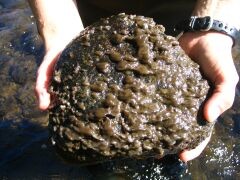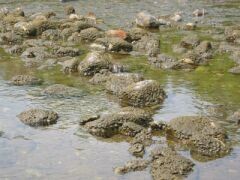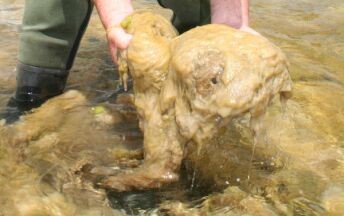Didymo (Rock Snot) Fact Sheet
The invasive algae known as Didymo has been found in the Elk River in the Webster Springs area following reports from anglers that heavy algal mats were seen in the Elk River. DNR staff collected samples from three locations near Webster Springs. The samples were sent to the Maryland Department of Natural Resources for confirmation. All three samples contained Didymo.
Didymo is a common name for Didymosphenia geminata, a freshwater diatom species that can form extensive mats on stream beds. The thick mats can smother native algae and aquatic insects, and make fishing very difficult. These thick mats appear slimy, but feel more like cotton or wool fabric. The algal mats are also called “rock snot” and can be white, yellow or brown in color. The algae form stalks that attach to rocks. While the algae eventually die and break off, the stalks persist and may impact stream habitats and aquatic organisms for weeks or months.
Didymo is native to the northern latitudes of North America, Europe and Asia. Its range has expanded and it now can be found in rivers in the western United States and more recently in Maryland, New York, New Hampshire, Pennsylvania and Vermont. It has also been found in three western Virginia rivers (Jackson, Pound and Smith).
WV Didymo Poster
WV Wildlife Didymo TV Spot
 
What precautions should everyone take to avoid spreading Didymo?
Recreational users of West Virginia’s aquatic resources have the potential to spread aquatic invasive species and fish and wildlife pathogens from stream to stream and watershed to watershed. Responsible stewards of our state waters take precautions to minimize the spread of these threats. Follow these ‘Best Practices’ and Disinfection Procedures to minimize the spread of aquatic invasive species, such as Didymo, and fish and wildlife pathogens. This approach is modeled after New Zealand’s widely-used ‘Check, Clean, Dry’ strategy.
BEST PRACTICES for minimizing the spread of Didymo, other aquatic invasive species, and fish and wildlife pathogens:
- Anglers - Consider the use of easily disinfected wading gear. For example, rubber-soled wading boots with cleats are easier to disinfect quickly than felt-soled boots.
- All Users - Disinfect your gear and boat before traveling between different bodies of water or watersheds (see below).
- All Users - If you move around to fish, boat, play or work, construct and use a simple, portable disinfection kit.
- All Users - Visually inspect your boat, gear and equipment before entering and leaving the water. Remove all plants, plant fragments, animals, mud or other debris and discard in the trash.
- Anglers - When practical, fish in a downstream direction. This doesn’t mean you can’t wade upstream a bit to fish that nice run upstream – think on a watershed scale. By fishing at the mouth of a large river in the morning, then going to the headwaters in the afternoon without disinfecting your gear, you’ve potentially spread Didymo upstream to the whole stream, which may not have been previously infected. Most algae and aquatic invasives/pathogens can’t swim upstream.
- Anglers, Guides, Outfitters - Designate waders/boots/canoes/tubes for different watersheds or have multiple sets available for same-day travel, when needed.
- Canoeists, Kayakers, Boaters, Tubers - Remove drain plug and drain any water prior to leaving boat loading/unloading area. Don’t move water between waterbodies.
How can I properly disinfect my recreational equipment?
DISINFECTION PROCEDURES – Disinfect prior to moving to another waterbody, watershed, or upstream site
There are a number of disinfection techniques that will kill most aquatic invasive species and fish and wildlife pathogens, including Didymo. Solutions of bleach or dishwashing detergent products are suggested as they provide the best combination of availability, cost AND effectiveness against Didymo as well as other aquatic invasive species and fish and wildlife pathogens, such as whirling disease. Choose the appropriate agent based on the actual items requiring disinfection (i.e. bleach solutions can damage some items). It is recommended that all disinfected equipment be rinsed on dry land, away from state waters. It is preferable to drain used solutions into treated wastewater (e.g. pour down a sink drain).
Non-absorbent items (boats, canoes, rubber waders, ‘hard-sided’ objects)
- Dishwashing Detergent: soak and scrub for at least one minute in 5% solution (add 6.5oz of detergent with water to make one gallon). ‘Green’ products are less effective and not recommended for disinfecting.
- Bleach: soak or spray all surfaces for at least one minute in 2% household bleach (2.5oz with water added to make one gallon). Bleach solutions must be replaced daily to remain effective.
- Hot Water: soak for at least one minute in very hot water (above 140°F – hotter than most tap water) OR for at least 20 minutes in hot water kept above 120°F (hot tap water, uncomfortable to touch).
- Drying: Drying will kill Didymo, but slightly moist environments will support some organisms for months. This approach should only be used for gear that can be left in the sun for extended periods of time (i.e. a canoe that’s left in the yard for several days between uses).
- Freeze: Place item in freezer until solid.
Absorbent items require longer soaking times to allow thorough penetration into the materials. Felt-soled waders, for example, are difficult and take time to properly disinfect. Other absorbent items include clothing, wetsuits, sandals with fabric straps, or anything else that takes time to dry out. The thicker and denser a material, the longer it will require for adequate disinfection. Err on the side of caution. Bleach solutions are not recommended for absorbent materials.
- Hot Water: Soak items for at least 40 minutes in very hot water kept above 140°F (hotter than most tap water).
- Dishwashing Detergent and hot water: (‘Green’ products are less effective and not recommended for disinfecting): soak for 30 minutes in a hot 5% detergent/water solution kept above 120°F.
A simple, portable DISINFECTION KIT might include:
- Large trash can and/or medium sized Rubbermaid-type bin for soaking wading boots
- Large stiff bristle brush for scrubbing
- Spray bottle(s) or herbicidal pump spray can(s)
- Graduated cylinder or measuring cup
- 5% detergent solution and/or 2% bleach Solution
What should I do if I think I’ve found Didymo?
Please contact the DNR fisheries biologist at the nearest district office to report possible Didymo outbreaks.
Other sources of information on Didymo
http://www.epa.gov/region8/water/didymosphenia/International%20fact%20sheet.pdf
http://www.epa.gov/region8/water/didymosphenia/didymo_field_guide.pdf
http://www.vtwaterquality.org/lakes/docs/ans/lp_dididguide.pdf

Didymosphenia geminata Identification
|
YES |
NO |
Location |
mostly clear flowing water with rocky bottom, may be attached to plants |
deep silty areas with no rocks or plants, highly colored waters |
Color |
tan, light brown or whitish |
green or dark brown/black
clear or transparent |
Texture |
clumps or ropy strands, rough cottony feel, fibrous |
thin layers, slippery or gelatinous |
Appearance |
no leaves or roots (BUT may attach to leaves or stems); Sometimes mistaken for fiberglass, toilet paper or tissue |
has leaves or roots
looks like an aquatic plant |
|
.gif)
.gif)



